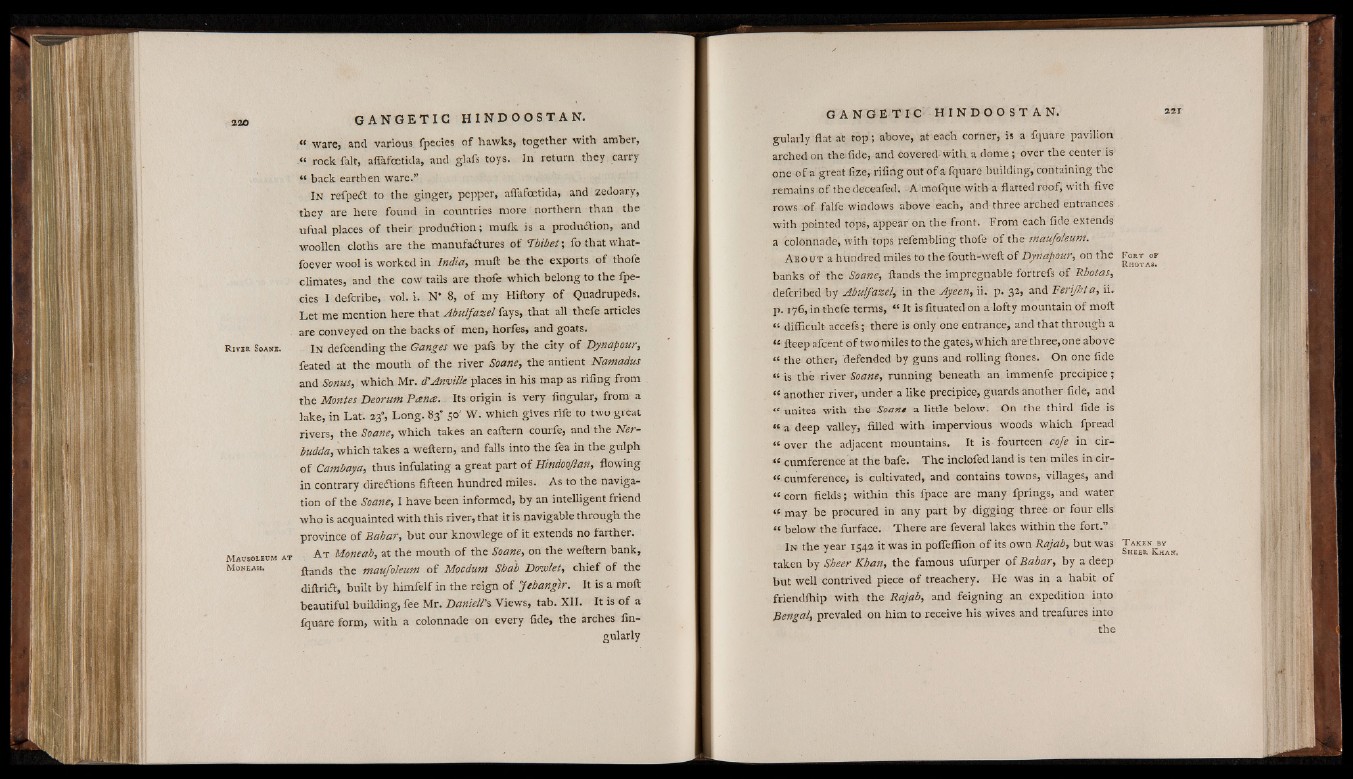
“ ware, and various fpecies of hawks, together with amber,
“ rock fait, afiafcetida, and glafs toys. In return they carry
“ back earthen ware.”
In refpedt to the ginger, pepper, afiafoetida, and zedoarv,
they are here found in countries more northern than the
ufiial places o f their produition; mulk is a production, and
woollen cloths are the manufactures of ‘Thibet; fo that what-
foever wool is worked in India, muft be the exports of thofe
climates, and the cow tails are thofe which belong to the fpecies
I defcribe, vol. i. N* 8, of my Hiftory o f Quadrupeds.
Let me mention here that Abulfazel fays, that all theie articles
are conveyed on the backs of men, horfes, and goats.
R iv e r Soane. In deicending the Ganges we pais by the city o f Dynapour,
feated at the mouth of the river Soane, the antient Namadus
and Sonus, which Mr. d'Anville places in his map as rifing from
the Montes Deorum Pee me. Its origin is very Angular, from a
lake, in Lat. 23% Long. 83° 50' W. which gives rife to two great
rivers, the Soane, which takes an eaftern courfe, and the Ner-
budda, which takes a weftem, and falls into the fea in the gulph
o f Cambaya, thus infulating a great part o f Hindoojtan, flowing
in contrary directions fifteen hundred miles. As to the navigation
of the Soane, I have been informed, by an intelligent friend
who is acquainted with this river, that it is navigable through the
province of Bahar, but our knowlege o f it extends no farther.
M a u s o l e u m a t A t Moneab, at the mouth of the Soane, on the weftern bank,
M o n e a h . ftands the maujoleum of Mocdum Shah Dowlet, chief of the
diftrift, built by himfelf in the reign of Jchanglr. It is a mod
beautiful building, fee Mr. Danielle Views, tab. XII. It is of a
fquare form, with a colonnade on every fide, the arches Angularly
gularly flat at top; above, at each comer, is a fquare pavilion
arched on the fide, and covered with a dome; over the center is
one of a great fize, rifing out o f a-fquare building, containing the
remains of the deceafed. A mofque with a flatted roof, with five
rows of falfe windows above each, and three arched entrances
with pointed tops, appear on the front. From each fide extends
a colonnade, with tops refembling thofe of the maufoleum.
A b o u t a hundred miles to the fouth-weft of Dynapour, on the F o r t o f
R h o t a s .
banks of the Soane, ftands the impregnable fortrefs of Rhotas,
defcribed by Abulfazel, in the Ayeen, ii. p. 32, and Ferijhta, ii.
p. 176, in thefe terms, “ It is fituated on a lofty mountain of moft
“ difficult accefs; there is only one entrance, and that through a
“ fteep afcent o f two miles to the gates, which are three, one above
“ the other, defended by guns and rolling ftones. On one fide
“ is the river Soane, running beneath an immenfe precipice;
“ another river, under a like precipice, guards another fide, and
“ irnites with the Soane a little below. On the third fide is
« a deep valley, filled with impervious woods which fpread
“ over the adjacent mountains. It is fourteen cofe in cir-
ii cumference at the bafe. The inclofed land is ten miles in cir-
cumference, is cultivated, and contains towns, villages, and
“ corn fields; within this fpace are many fprings, and water
<6 may be procured in any part by digging three or four ells
“ below the furface. There are feveral lakes within the fort.”
In the year 1542 it was in poffeffion o f its own Rajah, but was
taken by Sheer Khan, the famous ufurper oS Bahar, by a deep
but well contrived piece of treachery. He was in a habit of
friendffiip with the Rajah, and feigning an expedition into
JBengal, prevaled on him to receive his wives and treafures into
the